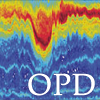
|
Geoff Shilling Principal Engineer gbs@apl.washington.edu Phone 206-221-7261 |
Education
B.S. Mathematics & Physics, Bates College, 1988
|
Publications |
2000-present and while at APL-UW |
The Southern Ocean mixed layer and its boundary flexors: Fine-scale observational progress and future research priorities Swart, S., and 14 others including C. Lee and G. Shilling, "The Southern Ocean mixed layer and its boundary flexors: Fine-scale observational progress and future research priorities," Phil. Trans. R. Soc. A, 381, doi:10.1098/rsta.2022.0058, 2023. |
More Info |
8 May 2023 |
|||||||
|
Interactions between the upper ocean and air–ice–ocean fluxes in the Southern Ocean play a critical role in global climate by impacting the overturning circulation and oceanic heat and carbon uptake. Remote and challenging conditions have led to sparse observational coverage, while ongoing field programmes often fail to collect sufficient information in the right place or at the time-space scales required to constrain the variability occurring in the coupled ocean–atmosphere system. Only within the last 10 years have we been able to directly observe and assess the role of the fine-scale ocean and rapidly evolving atmospheric marine boundary layer on the upper limb of the Southern Ocean's overturning circulation. This review summarizes advances in mechanistic understanding, arising in part from observational programmes using autonomous platforms, of the fine-scale processes (1–100 km, hours-seasons) influencing the Southern Ocean mixed layer and its variability. We also review progress in observing the ocean interior connections and the coupled interactions between the ocean, atmosphere and cryosphere that moderate air–sea fluxes of heat and carbon. Most examples provided are for the ice-free Southern Ocean, while major challenges remain for observing the ice-covered ocean. We attempt to elucidate contemporary research gaps and ongoing/future efforts needed to address them. |
|||||||||
Improving situational awareness in the Arctic Ocean Rainville, L., and 22 others including C.M. Lee and G.B. Shilling, "Improving situational awareness in the Arctic Ocean," Front. Mar. Sci., 7, doi:10.3389/fmars.2020.581139, 2020. |
More Info |
25 Nov 2020 |
|||||||
|
To successfully operate in a harsh environment like the Arctic Ocean, one must be able to understand and predict how that environment will evolve over different spatial and temporal scales. This is particularly challenging given the on-going and significant environmental changes that are occurring in the region. Access to the most recent environmental information provides timely knowledge that enables ship-based operations to proceed efficiently, effectively and safely in this difficult arena. Knowledge of the evolving environmental conditions during a field campaign is critical for effective planning, optimal execution of sampling strategies, and to provide a broader context to data collected at specific times and places. We describe the collaborations and processes that enabled an operational system to be developed to provide a remote field-team, located on USCGC Healy in the Beaufort Sea, with near real-time situational awareness information regarding the weather, sea ice conditions, and oceanographic processes. The developed system included the punctual throughput of near real-time products such as satellite imagery, meteorological forecasts, ice charts, model outputs, and up to date locations of key sea ice and ocean-based assets. Science and operational users, as well as onshore personnel, used this system for real-time practical considerations such as ship navigation, and to time scientific operations to ensure the appropriate sea ice and weather conditions prevailed. By presenting the outputs of the system within the context of case studies our results clearly demonstrate the benefits that improved situational awareness brings to ship-based operations in the Arctic Ocean, both today and in the future. |
|||||||||
Multi-month dissipation estimates using microstructure from autonomous underwater gliders Rainville, L., J.I. Gobat, C.M. Lee, and G.B. Shilling, "Multi-month dissipation estimates using microstructure from autonomous underwater gliders," Oceanography, 30, 49-50, doi:10.5670/oceanog.2017.219, 2017. |
More Info |
1 Jun 2017 |
|||||||
|
Ocean turbulence is inherently episodic and patchy. It is the primary mechanism that transforms water mass properties and drives the exchanges of heat, freshwater, and momentum across the water column. Given its episodic nature, capturing the net impact of turbulence via direct measurements requires sustained observations over extended temporal and/or broad spatial scales. |
|||||||||






